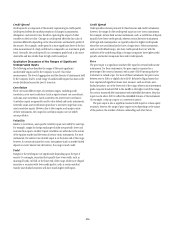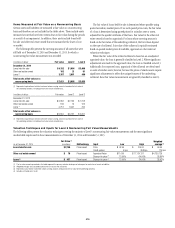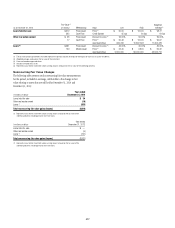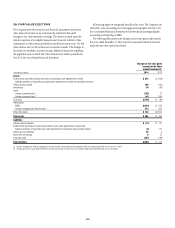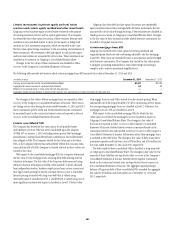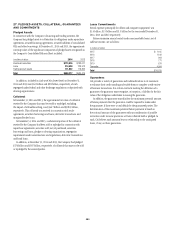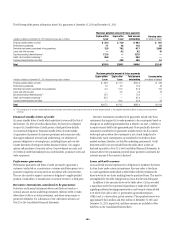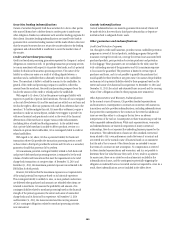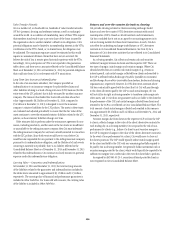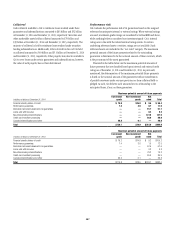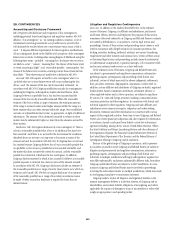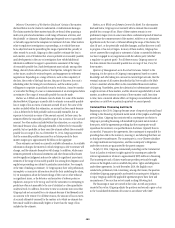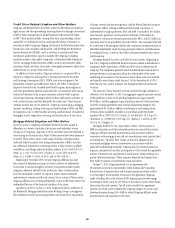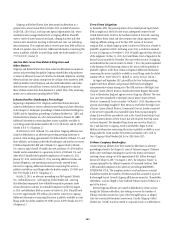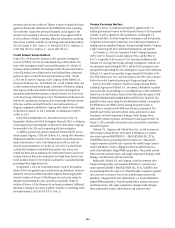Citibank 2014 Annual Report Download - page 302
Download and view the complete annual report
Please find page 302 of the 2014 Citibank annual report below. You can navigate through the pages in the report by either clicking on the pages listed below, or by using the keyword search tool below to find specific information within the annual report.285
Credit card merchant processing
Credit card merchant processing guarantees represent the Company’s indirect
obligations in connection with: (i) providing transaction processing services
to various merchants with respect to its private-label cards; and (ii) potential
liability for bank card transaction processing services. The nature of the
liability in either case arises as a result of a billing dispute between a
merchant and a cardholder that is ultimately resolved in the cardholder’s
favor. The merchant is liable to refund the amount to the cardholder. In
general, if the credit card processing company is unable to collect this
amount from the merchant, the credit card processing company bears the
loss for the amount of the credit or refund paid to the cardholder.
With regard to (i) above, Citi has the primary contingent liability with
respect to its portfolio of private-label merchants. The risk of loss is mitigated
as the cash flows between Citi and the merchant are settled on a net basis and
Citi has the right to offset any payments with cash flows otherwise due to the
merchant. To further mitigate this risk, Citi may delay settlement, require a
merchant to make an escrow deposit, include event triggers to provide Citi
with more financial and operational control in the event of the financial
deterioration of the merchant or require various credit enhancements
(including letters of credit and bank guarantees). In the unlikely event
that a private-label merchant is unable to deliver products, services or a
refund to its private-label cardholders, Citi is contingently liable to credit or
refund cardholders.
With regard to (ii) above, Citi has a potential liability for bank card
transactions where Citi provides the transaction processing services as well
as those where a third party provides the services and Citi acts as a secondary
guarantor, should that processor fail to perform.
Citi’s maximum potential contingent liability related to both bank card
and private-label merchant processing services is estimated to be the total
volume of credit card transactions that meet the requirements to be valid
charge-back transactions at any given time. At December 31, 2014 and
December 31, 2013, this maximum potential exposure was estimated to be
$86 billion for both periods.
However, Citi believes that the maximum exposure is not representative
of the actual potential loss exposure based on its historical experience.
This contingent liability is unlikely to arise, as most products and services
are delivered when purchased and amounts are refunded when items are
returned to merchants. Citi assesses the probability and amount of its
contingent liability related to merchant processing based on the financial
strength of the primary guarantor, the extent and nature of unresolved
charge-backs and its historical loss experience. At December 31, 2014
and December 31, 2013, the losses incurred and the carrying amounts
of Citi’s contingent obligations related to merchant processing activities
were immaterial.
Custody indemnifications
Custody indemnifications are issued to guarantee that custody clients will
be made whole in the event that a third-party subcustodian or depository
institution fails to safeguard clients’ assets.
Other guarantees and indemnifications
Credit Card Protection Programs
Citi, through its credit card businesses, provides various cardholder protection
programs on several of its card products, including programs that provide
insurance coverage for rental cars, coverage for certain losses associated with
purchased products, price protection for certain purchases and protection
for lost luggage. These guarantees are not included in the table, since the
total outstanding amount of the guarantees and Citi’s maximum exposure
to loss cannot be quantified. The protection is limited to certain types of
purchases and losses, and it is not possible to quantify the purchases that
would qualify for these benefits at any given time. Citi assesses the probability
and amount of its potential liability related to these programs based on the
extent and nature of its historical loss experience. At December 31, 2014 and
December 31, 2013, the actual and estimated losses incurred and the carrying
value of Citi’s obligations related to these programs were immaterial.
Other Representation and Warranty Indemnifications
In the normal course of business, Citi provides standard representations
and warranties to counterparties in contracts in connection with numerous
transactions and also provides indemnifications, including indemnifications
that protect the counterparties to the contracts in the event that additional
taxes are owed due either to a change in the tax law or an adverse
interpretation of the tax law. Counterparties to these transactions provide Citi
with comparable indemnifications. While such representations, warranties
and indemnifications are essential components of many contractual
relationships, they do not represent the underlying business purpose for the
transactions. The indemnification clauses are often standard contractual
terms related to Citi’s own performance under the terms of a contract and
are entered into in the normal course of business based on an assessment
that the risk of loss is remote. Often these clauses are intended to ensure
that terms of a contract are met at inception. No compensation is received
for these standard representations and warranties, and it is not possible to
determine their fair value because they rarely, if ever, result in a payment.
In many cases, there are no stated or notional amounts included in the
indemnification clauses, and the contingencies potentially triggering the
obligation to indemnify have not occurred and are not expected to occur. As a
result, these indemnifications are not included in the tables above.
Securities lending indemnifications
Owners of securities frequently lend those securities for a fee to other parties
who may sell them short or deliver them to another party to satisfy some
other obligation. Banks may administer such securities lending programs for
their clients. Securities lending indemnifications are issued by the bank to
guarantee that a securities lending customer will be made whole in the event
that the security borrower does not return the security subject to the lending
agreement and collateral held is insufficient to cover the market value of
the security.


